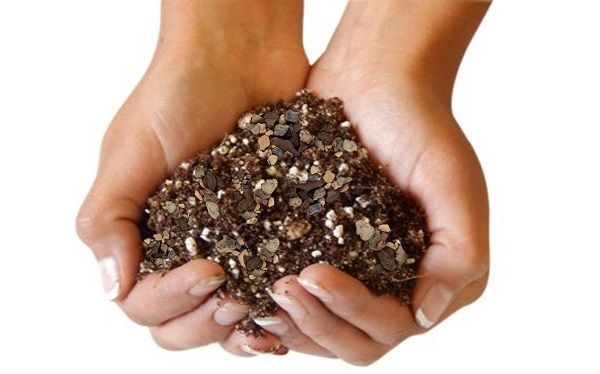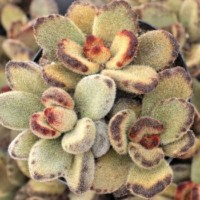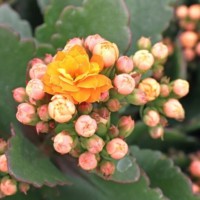Kalanchoe, (Kal-LAHN-sho) or (Kal-uhn-KOH-ee) is a genus of about 125 flowering succulent plants native to Africa and Asia. They boast colorful foliage, dazzling blooms and an intriguing range of shapes and textures. Some Kalanchoe succulents will thrive indoors, while others are best grown outdoors in mild climates. You are surely familiar with some of the remarkable members of the group like the silver panda plant, the paddle plant or flapjacks and the mother of millions or mother of thousands plants. Let’s take a closer look at the fun and fabulous Kalanchoe plant, propagation, and general Kalanchoe care.
All About Growing Kalanchoe
In this Post We'll Cover:
{Please note, some links in this post may be affiliate links to sites that pay me a small commission if you click on the link and make a purchase. This commission is at absolutely no cost to you. I only recommend products and companies that I have worked with and truly love! ~Kat}
Characteristics of the Kalanchoe Plant

Like all succulents, Kalanchoe store water in specialized cells in their leaves and stems to supply the plant during times of drought. They also have some less common adaptations to enable them to thrive in challenging conditions. Like Crassula, the Kalanchoe plant uses a metabolic adaptation called Crassulacean Acid Metabolism, or CAM photosynthesis. This means that Kalanchoe respireTo respire - Respiration is the process where living beings,... More, or release oxygen to the air only at night, in order to conserve water during the heat of the day.
Kalanchoe tomentosa – Furry Leafed Panda Plant

The furry leaves of Kalanchoe tomentosa have inspired names like the panda plant, pussy ears, donkey ears and plush plant. The silvery variety seen above is most often called the silver panda plant. A version in a soft cinnamon color, is Kalanchoe tomentosa ‘Chocolate Soldier’ is often called a chocolate soldier. Both have the same, velvety, pettable fur. These furry succulents are so charming, breeders have developed several more, in slightly different colors, shapes and fuzz. These furry friends include K. tomentosa ‘Hairy Harry’, ‘Teddy Bear’, ‘Cinnamon’ and ‘Black Tie’. In fact, some of the best fuzzy succulents are Kalanchoe varieties. This fur or fuzz serves both to shade the surface of the leaves and to catch dew drops to provide additional water resources for the plant. The tall, narrow, furry leaves always bring to mind a bunny’s ears for me. Perfect for Easter!
Kalanchoe Plant and Epicuticular WaxEpicuticular wax (Ep-i-cyoo-TI-cyoo-lar wax) is a natural, ...

Other Kalanchoe varieties produce epicuticular wax, the powdery white film you see on the surface of some varieties of succulents. This is a waxy film the plant produces that protects the leaf from sun damage. Additionally, epicuticular wax helps the plant to conserve its moisture, slowing the rate of water loss through the surface of the leaves. The Kalanchoe oak leaf shown above is one of many varieties that display this useful adaptation.
Kalanchoe Mother of Thousands – Leaf Tip Plantlets

By far, the strangest adaptation among Kalanchoe plants is this – producing baby plantlets along the margin of the leaves. Two incredible varieties sport a series of plantlets on their leaves. Kalanchoe daigremontianum, above, is known as devil’s backbone, Mexican hat plant, alligator plant or mother of thousands plant. A similar variety, with much more slender leaves is Kalanchoe tubiflora – called mother of millions plant. These plantlets form early and often, eventually developing roots and detaching from the mother’s leaves, they fall to earth, and form their own plant. This easy and seemingly profligate propagation can lead to these plants taking over if you are not watchful. But with little care, these varieties will grow your succulent collection quickly and easily. Some people routinely pot up the new young Kalanchoe plants to gift to family and friends.
Kalanchoe Flowers

Kalanchoe blossfeldiana is one of the most dazzling flowering succulents there is, and it is certainly the finest for growing indoors. But all Kalanchoe varieties produce striking blooms, as the image above will attest. In order to flower, the Kalanchoe plant must have reached maturity. The timing this takes varies by variety. Early spring is typically the season for Kalanchoe flowers, and the bees and butterflies love them! Sometimes, gardeners are not so thrilled to see these flowers. This is because some varieties, like the large leafed flapjacks plant or paddle plant are monocarpicMonocarpic (Mon-oh-CAR-pic) plants are those that flower, se....
A monocarpic plant will flower just once, and then it dies. This is not a cause for grief because the mother plant produces many offsetsSucculent offsets are the baby succulents that form at the b... between blooming and death. However, the change is undeniable. What was once a large plant you may have nurtured for years suddenly becomes a cluster of 20-35 little plants. And the shape of your plant may change drastically during the bloom as well. On an individual basis, this can be fascinating. But if the mother plant was the foundation of a mixed arrangement or border, it may become an unfortunate change of scale. These photos by the incomparable Debra Lee Baldwin illustrate this perfectly:


On the left is a handsome, mixed succulent border with Kalanchoe luciae, the paddle plant. On the right, the same border shows the K. luciae in bloom. The entire plant elongates and is then topped with these curious blooms. If you prefer to forgo the baby plants and to keep the original plant in its condition, remove the flower stem as it forms. This is the plant’s effort to reproduce, so it may be stubborn and continue its efforts. Just continue to cut off the flower spike as it forms. This will not harm the plant, and will keep it looking tidy.
Not all Kalanchoe varieties are monocarpic. Typically it is just those with overlapping leaves formed on a single stem.
Kalanchoe Colors Change

Many succulents change color in response to changing environmental cues, known as stress — and Kalanchoe are no exception. The Kalanchoe luciae, or the paddle plant or flapjacks above is a perfect example. The plant on the left, with the red margins, can flush just as bright and fully scarlet as the plant on the right. Neither is “sick” or has a problem. The amount of daylight, sun exposure and temperature combine to influence the color of your Kalanchoe plant leaves. The color is the result of naturally occurring antioxidants in the succulents’ leaves called anthocyanins. Some food plants like berries, cherries and red cabbage also contain anthocyanins. The purpose they serve the succulent is to protect it from damage due to excess exposure to UV rays and temperature extremes. The result is a lovely flush of color in full sun, and in the changing temps of fall and spring.
Kalanchoe Care

Lighting for Kalanchoe
Kalanchoe care is very simple. They are generally hardy outdoors in climate zones 9-11, and can be over-wintered indoors in colder climates. Provide lots of bright light. Outdoors, most Kalanchoe will thrive in a range of partial shade to full sun.
Succulent Soil for Kalanchoe Plants

The proper succulent soil is important for Kalanchoe care and correct watering. You will need a fast-draining, gritty soil mix for growing your Kalanchoe, either in the ground or in containers. There are good recipes online, or just use a soil formulated for cactus and palm trees for great results.
Watering Kalanchoe

As with all succulents, proper watering for Kalanchoe is absolutely critical to their health and survival. The adaptations succulents have made to thrive in drought conditions makes them wonderfully low-maintenance plants. But it also leaves them vulnerable to severe damage or even death if they are over-watered. How to water your succulents isn’t hard, and the plant will tell you what it needs! Basically, it boils down to watering only when the soil is dry, to ensure the plant doesn’t get more water than it can utilize. For a detailed review of how to water your succulents, please read the article here.
PropagatingPropagating (PRAH-puh-gate-ing) a plant is to grow another p... Kalanchoe

In addition to rooting the plantlets formed on the leaf margin by a few varieties, all Kalanchoe are easily propagated by stem cuttings and by their leaves. For stem cuttings, cut a piece 2-4 inches long, and remove the leaves from the bottom 1-2 inches. Set the leaves aside to propagate them as well! Insert the cutting stem into dry succulent soil, and be sure to cover the exposed nodes. After a week, mist the soil well with water and leave it dry again for another week. Continue this process for 4-6 weeks. Then, gently pull up on the cutting. If it comes up easily, check for baby roots. If it resists coming out of the soil, new roots are forming and anchoring into the surrounding soil. At this point, slowly increase the water you provide weekly, and slowly bring the plant into more light.
Kalanchoe Types
Kalanchoe succulents have a wonderful variety of colors, forms and textures. Thus us not a genus where all the plants sort of look alike!
Where to Buy Kalanchoe Plants

You can find a few Kalanchoe varieties at most home stores or nurseries. For a reliable online source of exceptional quality plants, I highly recommend Mountain Crest Gardens. They offer 20+ different, colorful Kalanchoe varieties at Mountain Crest Gardens, and every plant I have ordered from them has arrived in perfect condition.
I hope you have enjoyed this review of the Kalanchoe genus. Are you already growing some, or are you ready to start? Please take a moment to leave a comment – I would love to hear from you!
You can do this!

P.S. For my FREE course, 7 Steps to Succulent Success, please subscribe! Thanks so much!
P.P.S. Why not join my Facebook Group for succulent lovers? We talk about succulent care, propagation, succulent identification, and design. It’s a warm and welcoming group that would love to meet you!

























